Fiji
Kokomo Private Island, a Marine Masterpiece
Craig Osment is transported to another level of luxury and otherworldly peace at one of Fiji’s most stunning island resorts where he finds a deep commitment to maintaining its earthly advantages.
August 27, 2019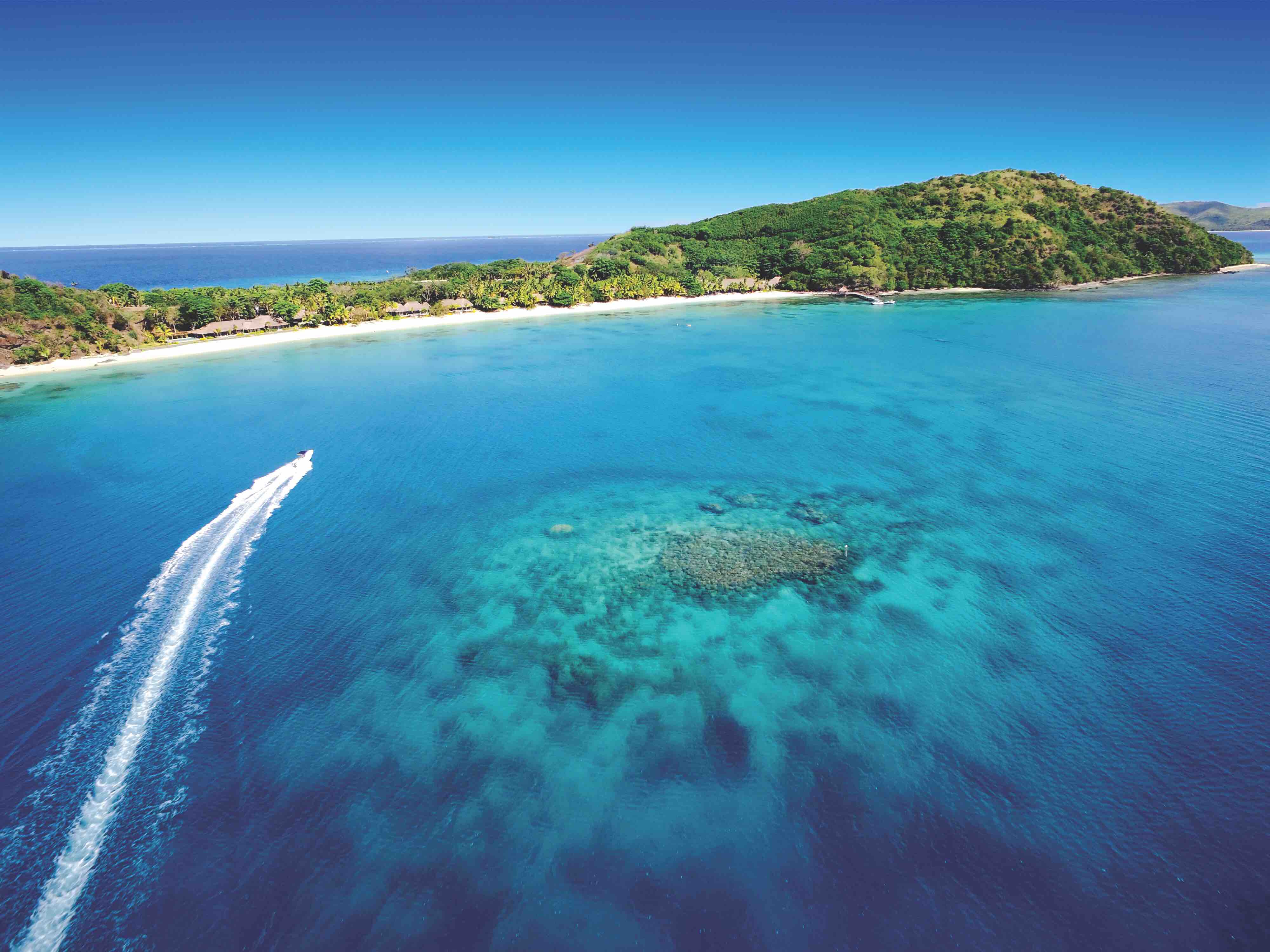
Rebecca Murphy
August 27, 2019Marine biologist Cliona O’Flaherty says ‘I’m Irish actually’ – really! With that accent and name? She qualified as a zoologist in Dublin and made a circuitous trip to Fiji via Africa. She’s also a qualified dive instructor and that is how she landed her original job at Kokomo Private Island.
Prior to our meeting to discuss her work here we were told by resort manager Jacques Louw that we’d find her ‘passionate’ about her reef restoration work and marine conservation and after an hour and a half of conversation we were in no doubt about her commitment to maintaining Fiji’s unique underwater world and its mangroves.
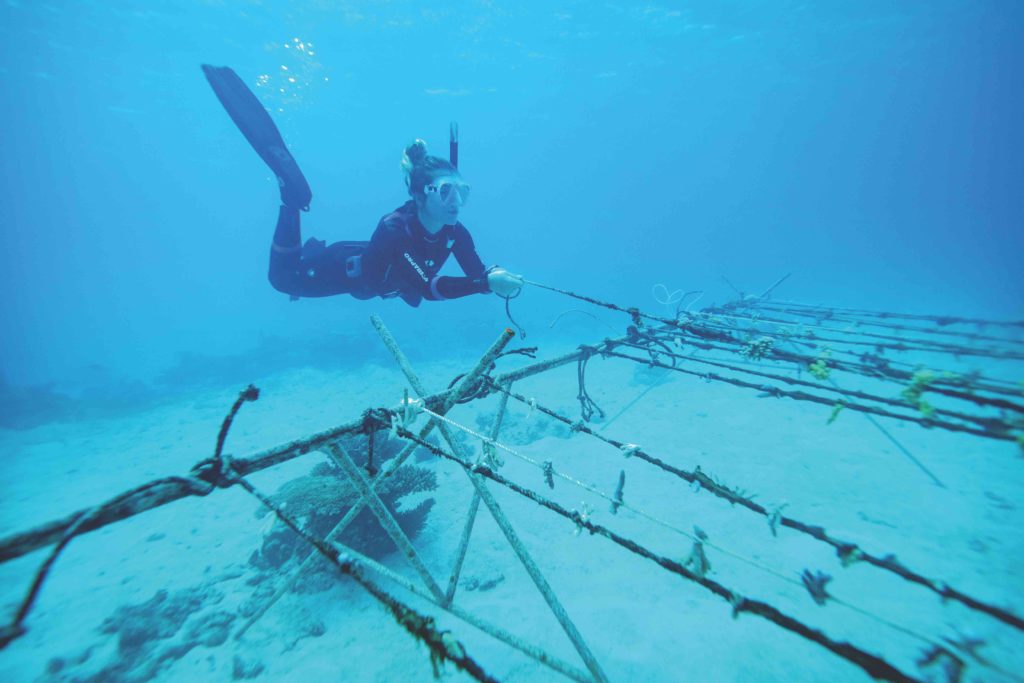
She has set up a coral nursery to propagate species which are suited to warmer water, they are attached to ropes on a frame and allowed to grow for up to six months before being transplanted to the reef using an adhesive patty of cement and sand. This is an activity in which guests are invited to participate with the hope that 2000 corals will be transplanted this year.
Apart from the coral garden she is also in the midst of initiating, in conjunction with the UN’s Manta Trust, an electronic acoustic tagging program which is designed to keep track of these harmless and extraordinary creatures which cruise the nearby reefs. The local variety have wingspans of up to four metres and can be found, in season, barrel-rolling quite close to shore with no apparent objection to humans getting up close with snorkels and masks. Cliona is the perfect guide when you’re touring the reef in the resort’s glass bottom boat, she knows every coral species and where to find the manta rays. Her work has just been recognised by Women in Travel with the well deserved and prestigious Sustainable Practices Champion award.
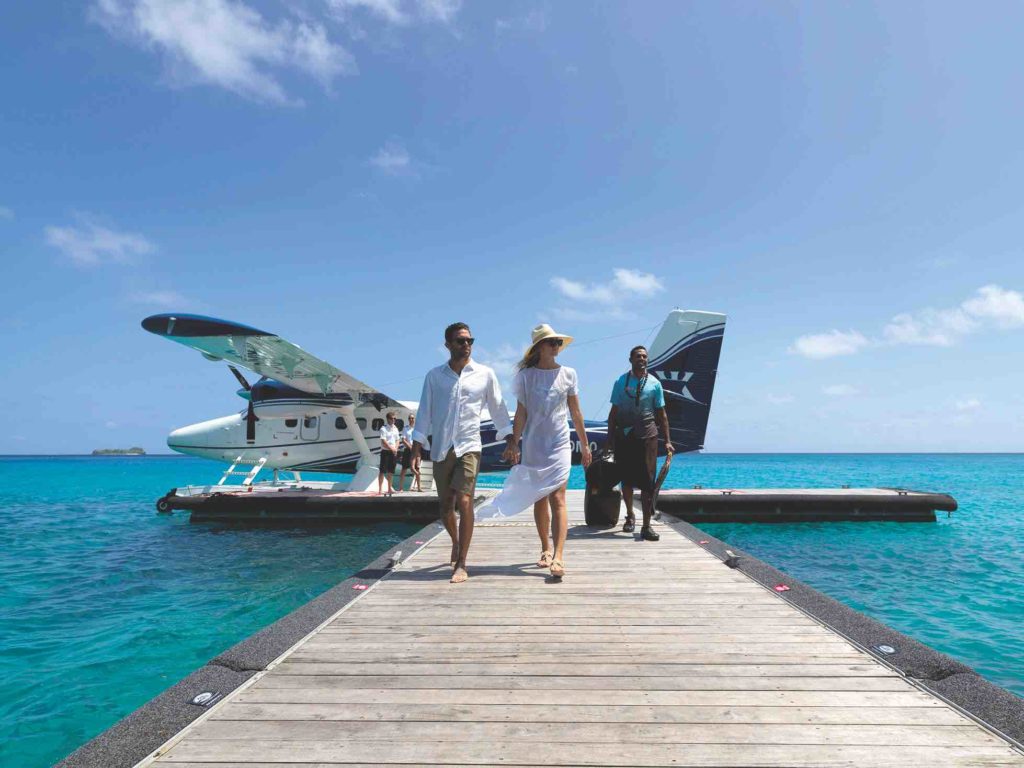
Her enthusiasm for conservation is funded and encouraged by the resort’s developer and owners, Australian billionaire Lang Walker and his wife Sue. Cliona insists that the great advantage of working for an individual with a shared zeal is that decisions to advance the cause are made quickly and put into action much faster than traditionally funded academic research.
It seems that this pursuit is not the only one that is assisted by ‘Lang’s’ (Lang’s name is invoked regularly by all the staff and there is no doubt that his influence and hand is everywhere) dedication to his island indulgence, his eco-sensitive vision is responsible for a sustainability program on several fronts – from a hydroponic garden to a free range chook run for the egg-producing chickens, their own bee hives for honey production and a beautifully presented vegetable garden through to sustainable big game fishing. I also happened to notice that what looked like a plastic cup for my room-delivered orange juice was ‘made from plants, not oil’. The island has a water filtration system as well as a greywater and sewage treatment system. All in the interests of reducing the eco footprint from the expensive footwear of their well-heeled guests.
And you do need to have a substantial cash flow or be prepared to save for the holiday of a lifetime in order to experience the many delights of Kokomo. A one-night stay for two starts from a little over AU$4500 per night. That rate does include all food (but you pay for your booze) and a lot of other services including a fabulously quick and efficient laundry service, dedicated nannies, WiFi access and one introductory dive and spa voucher among other benefits. For all bookings, rates and facilities see website details at end of story.
No news, no shoes
Kokomo (named after a long line of Lang’s boats) opened a little over two years ago after having had millions of dollars lavished on the site – and it shows. Everything about this island reflects the perfectionist attitudes of the developer, having bumped into a couple of guests who are FOL (friends of Lang) we were assured that Lang doesn’t compromise on quality, and it shows. The gardens alone are tended by 50 landscapers and gardeners; almost 300 people (mostly locals)are employed to service the infrastructure and guests which at maximum capacity number 135 lucky inhabitants. So the service is not only instant and unobtrusive but typically Fiji-friendly and welcoming.
From the moment of ‘first contact’ at Nadi International Airport to the island’s recently opened private aviation terminal through to the amphibious Twin Otter’s pontoons skimming the bay in front of the resort – the service is seamless and professional. The musical greeting at the door is performed by staff and culminates in the inevitable ‘bula’.
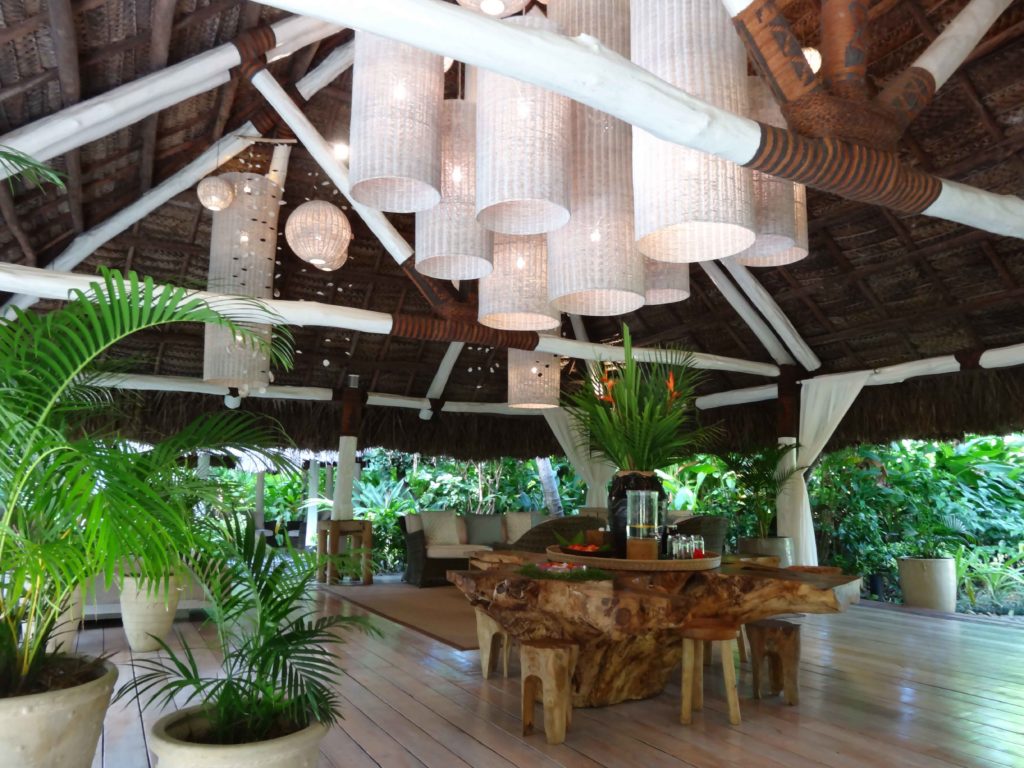
Kokomo claims to offer ‘relaxed luxury’ and that approach is confirmed when the plane’s co-pilot emerges from the cockpit with bare feet which he explains is most appropriate for an island. And for this island that is absolutely the case, there is no formality here, the emphasis is on relaxing in Fijian island-style comfort with the beach at your door and sand between your toes while your every need is taken care of. As they say about luxurious isolation – ‘no news, no shoes’.
And, for something even more relaxing the Yaukuve (the island’s traditional name) Spa Sanctuary is the ultimate in soothing, sensory indulgence. After a greeting at the main colonial style building it’s off to the welcome pavilion where a hibiscus infusion and cold towel await along with a couple of Fijian masseuses ready to discuss exactly how much pressure we’d like applied during our scheduled 75-minute hot seashell massages. These take place in a bure for two which is to be found further along a pebble-paved path deeper into the lush jungle-like surrounds. I emerge ready to hug a tree or slip into a trance having been transported to another level of what must be ‘mindfulness’.
Protected by the great Astrolabe Reef
Our villa is one of 21 which front directly on to either one of the west or east facing beaches on either side of this glorious 57-hectare island. The villas range in size from one to three bedrooms and are supplemented by five ‘residences’ of up to six bedrooms for larger groups or the publicity-shy. All villas have private infinity pools and large living and sleeping spaces with both indoor and outdoor bathrooms stocked with Pure Fiji products, a kitchenette with coffee machine and fridge and a shaded dining table on the deck which is perfect for in-villa dining.
The Fijian vernacular architecture features careful detailing including intricately braided fibre bindings on the ceiling beams, specially commissioned artworks by Lang family friend Chris Kenyon and island artefacts. The colour palette is neutral and understated, which perfectly complements the blazingly vibrant sea, sand and sky beyond the glass doors and thatched eaves leading to the garden.
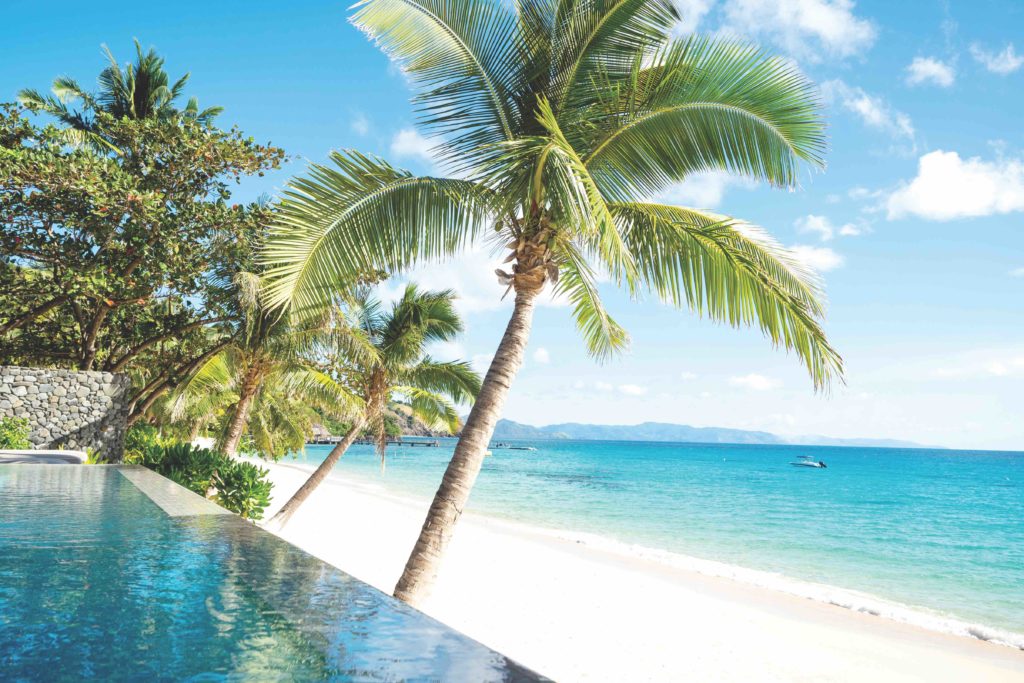
The island is part of the Kadavu Group off the southern end of Viti Levu, about a 25-minute helicopter ride from Suva. This group is encircled by the Great Astrolabe Reef, which is the world’s fourth largest and famous for its sea life. Protected as it is by this natural wonder the susurration of the sea lapping the beach is the only external sound you’re likely to hear during your stay, well, apart from the occasional coming and going of the seaplane which is cause for some excitement and a photo op. Land transport is taken care of by electric buggies which can be called up for delivery to one of the three dining destinations at any time and seem to arrive at the entrance portico within seconds of having put down the phone.
Our Hemingway moment
Sea transport for us was the resort’s Riviera 40 fishing boat retrofitted with a tuna tower and captained by renowned fishing expert Jaga Crossingham. Jaga is a lithe and laconic Australian who is as passionate and knowledgeable about fishing as Cliona is about coral. Having never been big game fishing before we set off with the expectation that possibly no fish might be harmed during the course of this excursion, believing that fishing is the triumph of patience over optimism, with lines trailing for hours on end with little activity as clever fish take baits and treat hooks with disdain. We were wrong.

Jaga not only knows his reef, he knows his sonar and was soon pointing to flurries of pixels on his radar screen which he assured us were big tuna. He rigged up two rods which he attached to either side of the transom and then proceeded to idle the massive and powerful engines while we awaited a ‘nibble’. When it happened the rod bent at an improbable angle as the line ran out at speed, Jaga was out of the captain’s chair and grabbing at the rod as he directed Demi, his deckhand, to constantly make small adjustments to the throttle so as to keep the boat above the fish as he sought to reel it in. When the gaff hook finally made contact with the prey and hauled it aboard it turned out to be a 30kg dogtooth tuna. Impressive! Next she-who-doesn’t-kill (my wife) landed a 7kg Spanish mackerel which was promptly dropped into in the icebox with the tuna – dinner was obviously taken care of.
But that wasn’t the end of the quest as Jaga still had a bait or two in the box and set up the lines again to be rewarded with another bite shortly after. This time he declared the fish to be another dogtooth tuna (based on its underwater behaviour), which he estimated to weigh 80-90kg. The size of the fish and the 30lb-breaking-strain line only made Jaga more determined to land it, in spite of already holding the world record for this type of fishing. We were suddenly having our Hemingway moment as the fish dived to the full 350-metre extent of the line before he managed, after a protracted struggle to haul it up to within 100 metres of the surface at which point the line snapped and the quarry was off back to its reef and we to the resort dock. Clinton the chef from the Beach Shack restaurant was there to greet us at 6pm and by eight the fish were on our plates. The tuna as sashimi and the mackerel pan fried with lemon butter and a fennel salad – the freshest fish I’ve ever eaten.
Kids welcome
The other beachside dining option is the rather cutely named Walker d’ Plank which is overseen by Fijian chef Caroline Oakley who has dispensed with menus in favour of a chat with guests about what is freshest in the kitchen and how you’d like it prepared. The emphasis here is super casual and the location is perfect for a pre-dinner cocktail while the sun descends behind the nearby islands. The food we choose is Asian influenced and presented as share plates which range across lobster, fish cakes, squid, tempura prawns, spring rolls and steamed dim sums accompanied by a bottle of South Australian Shiraz.
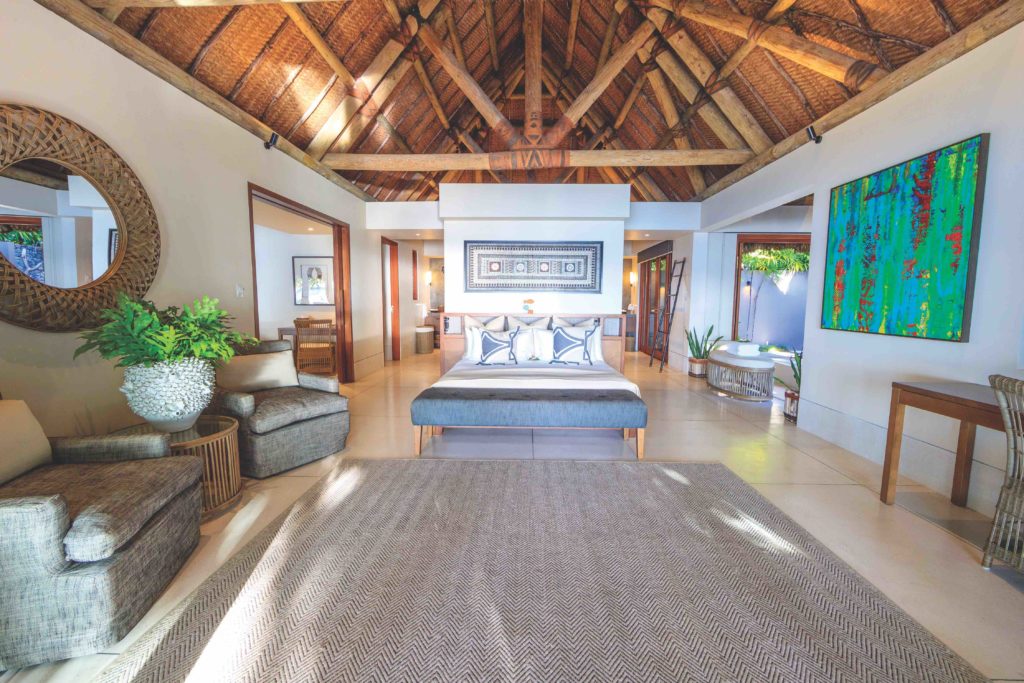
Another lunch or dinner option is Kokocabana which is adjacent to the large public pool. The cabana has a smoothie, juice and dessert bar which is open all day and features a wood-fired pizza oven with a build-you-own pizza selection. This is also where the kids and teenagers hang out with all sorts of distractions designed to keep them occupied for hours.
In addition to reef visits and fishing there is also a large selection of other diversions for those who are averse to too much lying around the pool. The list includes: paddle boarding, sailing, yoga, snorkelling – either right off the beach or further afield, scuba diving, kayaking, there’s a sea trampoline moored off the eastern beach, private boat charters, motorised water sports and sunset cruises as well as cultural activities and a gymnasium. You can also travel to a nearby island for a walk to a cooling waterfall or take the farm or village tour.
And if you find all this just so overwhelmingly romantic and you’re up for it you can arrange to marry here with everything taken care of by the resort staff events team. Indeed Cliona was telling me that she has a couple planning some coral gardening and a manta ray tagging and naming experience for their wedding guests which should make for memorable nuptials apart from the idyllic island backdrop.
Unsurprisingly, Kokomo is a difficult place to leave as it doesn’t take long to assimilate to the lifestyle of the rich and famous. But the parting is made a little easier by the farewell song and the knowledge that the flight back to Nadi will take in spectacular views of the surrounding islands and that exotically named Great Astrolabe Reef.
Moce and Vinaka vaka levu! (Goodbye and thank you very much).
© 2024 Pacific Island Living Magazine all Rights Reserved
Website by Power Marketing